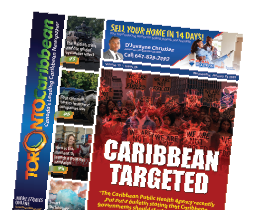on
BY SIMONE J. SMITH
Your co-worker is sitting at his desk, typing on his computer. He suddenly stops and looks confused, rubbing his temple. Noticing his discomfort you ask, “Are you okay?” He replies slurring, “I… I don’t know. I feel… strange.” “You don’t look so good,” you tell him. “Let me check something; can you smile for me?” He attempts to smile, but only one side of his mouth moves. “Okay, that’s Face,” you say to yourself. “One side is drooping.” “Can you lift both of your arms for me?” He raises his right arm, but his left arm stays limp by his side. “Arm weakness, got it.” “Can you repeat this sentence, ‘The sky is blue?’” He slurs heavily, “Th… Th… The sky… is… blue.” “Speech is slurred,” you note. “I think you might be having a stroke…”
An article titled, “Burden of Stroke and Population Attributable Fractions of Risk Factors in Latin America and the Caribbean,” reported that stroke burden and stroke-related mortality in Latin America and the Caribbean (LAC) are higher than the worldwide averages. However, stroke is a highly preventable disease in this region. Up to 90% of the burden could be reduced by targeting two modifiable factors: blood pressure and body mass index.
I wanted to research this topic a little more due to the fact that cardiovascular disease is prevalent in the Afro-Indo Caribbean community. I came across another article titled, “Prevalence and Incidence of Stroke in Latin America and the Caribbean; a Systematic Review and Meta-Analysis,” and it found that smoking, excessive alcohol consumption, unhealthy diet and sedentary lifestyle have increased in the last years in the LAC region specifically in Cuba.
Stroke continues to rise in Canada – more strokes are happening, and more people are living with stroke due to the aging population. It is important to note that since the onset of the pandemic, and the introduction of the COVID-19 vaccine, more younger people are having strokes. I note this because there are reports that we will be publishing and have published that have directly correlated a link between the certain vaccines, and an increase in strokes. It is not the focus of this article, but I want to ensure that we as citizens of Canada do not lose sight of what has been happening without us noticing it.
Based on the latest analysis from a Heart & Stroke funded study there are now approximately 108,707 strokes each year in Canada. That is roughly one stroke every five minutes. According to the most current and complete prevalence data, almost one million people in Canada are now living with stroke. Stroke is a leading cause of adult disability.
June is Stroke Month in Canada and Heart & Stroke is celebrating 10 years of raising awareness across the country around the importance of recognizing the FAST signs of stroke and the need to call 9-1-1 right away to get to the best hospital for stroke care. While progress has been made, more needs to be done to promote this life-saving information across the population.
In 2014 Heart & Stroke launched the FAST campaign as a simple and effective way to help Canadians recognize and remember the most common signs of stroke and know to act right away:
Face – is it drooping?
Arms – can you raise both?
Speech – Is it slurred or jumbled?
Time to call 9-1-1 right away.
Recognizing the signs of stroke and acting quickly (as demonstrated in the introductory scene) can mean the difference between life and death, or the difference between a better recovery and a lasting disability.
“Since launching the FAST signs of stroke campaign awareness has increased significantly,” says Dr. Patrice Lindsay, Lead, Stroke Best Practices Strategy, Heart & Stroke. “Working with governments and corporate, community, and health partners and with the support of our donors we have amplified the messages across the country. These messages need to be regularly repeated and targeted strategies are required to ensure they reach everyone.”
Heart & Stroke has been polling around recall of the FAST signs of stroke since the campaign launched. The results have clearly shown that while much progress has been made, not enough Canadians recognize the signs of stroke, and factors such as: gender, age and place of birth affect awareness. The FAST campaign recall poll results reveal much progress:
- The number of Canadians who can name at least two FAST signs of stroke has doubled over the past almost ten years from two in 10 to over four in 10.
- Over the past three years alone the number of Canadians who can name at least two FAST signs of stroke has increased from three in 10 to more than four in 10.
- Nearly six in 10 Canadians who have seen or heard the FAST campaign can name at least two of the FAST signs of stroke, compared to less than four in 10 of those who are not aware of the campaign.
- Women are more aware of the FAST signs of stroke than men.
- Older Canadians are more familiar with the signs of stroke and more likely to act.
- Newcomers are significantly less aware of the FAST signs of stroke and less likely to call 9-1-1 right away compared with those born in Canada.
- Many ethnically diverse communities are less likely to be familiar with the FAST signs of stroke.
If you are aware of cardiovascular diseases running in your family, it is crucial to take proactive care of your health. Pay close attention to how you feel physically and be vigilant for any signs of a stroke. Should you notice any symptoms, seek medical attention immediately. Your prompt action can make a significant difference.
Stay in the loop with exclusive news, stories, and insights—delivered straight to your inbox. No fluff, just real content that matters. Sign up today!
We, as humans are guaranteed certain things in life: stressors, taxes, bills and death are the first thoughts that pop to mind. It is not uncommon that many people find a hard time dealing with these daily life stressors, and at times will find themselves losing control over their lives. Simone Jennifer Smith’s great passion is using the gifts that have been given to her, to help educate her clients on how to live meaningful lives. The Hear to Help Team consists of powerfully motivated individuals, who like Simone, see that there is a need in this world; a need for real connection. As the founder and Director of Hear 2 Help, Simone leads a team that goes out into the community day to day, servicing families with their educational, legal and mental health needs.Her dedication shows in her Toronto Caribbean newspaper articles, and in her role as a host on the TCN TV Network.












